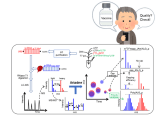Order, order!

In Robert MacNeill’s (Pharmaron; PA, USA) latest column, he describes the evolution of batch analysis in bioanalytical laboratories, emphasizing meticulous sample preparation and its alignment with analytical sequences to minimize errors and enhance troubleshooting. Robert reflects on the shift towards automation and updated guidance, advocating for thoughtful batch design and engagement with evolving practices.
 Robert MacNeill received his BSc with Honors in Chemistry from Heriot-Watt University and then his MSc in Analytical Chemistry from the University of Huddersfield, both in the UK. Robert is also a Chartered Chemist and a Fellow of the Royal Society of Chemistry. With decades of experience in all aspects of quantitative bioanalytical LC–MS method development, many of these years heading bioanalytical method development activities in the CRO domain, and a regular author and speaker, Robert is a recognized expert and innovator in the field.
Robert MacNeill received his BSc with Honors in Chemistry from Heriot-Watt University and then his MSc in Analytical Chemistry from the University of Huddersfield, both in the UK. Robert is also a Chartered Chemist and a Fellow of the Royal Society of Chemistry. With decades of experience in all aspects of quantitative bioanalytical LC–MS method development, many of these years heading bioanalytical method development activities in the CRO domain, and a regular author and speaker, Robert is a recognized expert and innovator in the field.
In his current role, Robert is Director of Bioanalysis at Pharmaron in Exton (PA, USA). In addition to directorship duties, he coordinates the bulk of LC–MS method development, also keeps abreast of innovation and technological development in the industry, leading in-house research projects and managing the associated technical writing.
Although analytical methodologies are one of very few things I would be prepared to pass judgement on, don’t worry, I am not approaching this article from that particular perspective. It’s more about the basic elements of batch analysis and how the best can easily be made of them. In the distant, rosy memories of my earliest days at the bioanalytical bench just on the outskirts of the beautiful city of Edinburgh, I learned that things had to be perfect. This includes in terms of simple batch layout, sample number and ID with description, and how this would translate to an autosampler plate map with corresponding well or vial positions. Yes, I was in this bioanalytical LC–MS game right before 96-well plates were “the business” in batchwise quantitative applications. Anyway, to ensure no mistakes in the samples I was preparing, I would have calibration standards lined up in a set in their duplicate pairs according to nominal level. Similarly, I would have quality control (QC) samples in their area, lined up with replicates grouped and separated by concentration. Blanks similarly grouped together in their small bunch. Then of course, any study samples would be in their particular area of my large metal rack, again lined up in order for analysis.
I knew as such that I would be highly unlikely to make a mistake in preparation, which would be shocking enough to forfeit my deep-fried haggis and chips that evening. I also knew that each position in the final autosampler tray, although not necessarily the same, would correspond to a sample number within my runlist, correlating with my layout. This would, naturally, all be dutifully checked.
When it came to the analytical endpoint, the sequence would be as per accepted best practice, starting with blanks, one half of the calibration line, QCs interspersed with study samples in a defined manner, then finishing with the other half of the calibration line and a small complement of blanks.
Now, if there was a problem with the batch, we could often make a diagnosis right away, arising from the fact that the analytical sequence did not reflect the order in which the samples were prepared and extracted. For example, suppose there was a signal drift that produced a line at the beginning of a very different slope to that of the line at the end. We can speculate confidently that the troublesome element must have been the LC–MS side of things, since the complete line was prepared and extracted at the same time, and a different order.
Therefore, with this in mind, we had a routine giving us every opportunity for “right first time, every time” and some decent means for a head start in any necessary troubleshooting. The curious thing, and the gist of this article, is that nowadays we have updated guidance pushing us to prepare and extract everything in the same order as what will be reflected in the final analysis. I must admit, if I was still a regular lab-based analyst I would endure some adjustment time and the question marks would be circling my head.
Why, we might ask, would there be a push in this way? What is the underlying reasoning? I can only speculate. An effort in keeping the sample preparation minimally complex, harnessing the element of being discrepancy-free, essentially by numerical ID, between analytical preparation list and injection order? Is it perhaps partially an artifact of a 96-well plate as the output from an automated extraction being often the same vessel from which the final injections are made? Perhaps this is gradually becoming a non-issue as we move into increasingly automated sample preparation. Robotic liquid handlers are doing more than ever before – including spiking up biological matrix with analytes and all the necessary bells and whistles like internal standard and buffer diluents – in astonishingly precise and reproducible fashion. Human error need not encroach.
There we have it, another serving of food for thought, sprinkled with a dash of sentimentality. The ordered manner in which we prepare the samples in analytical batches, and the comparative nature of the sequential chromatographic analysis, constitutes an important aspect of method performance, indeed laboratory performance. The right choices can be a big step toward mistake-free sample preparation, enabling a frequent wave good-bye to repeat analysis and compromised timelines. Remember, good science should be at the heart of the guidance and we must always be ready to engage, to ponder, to question and to listen.
Have at it with your great methods!
Interested in reading more of Robert MacNeill’s columns? You can find his collection here.
Disclaimer: the opinions expressed are solely that of the authors and do not express the views or opinions of their employers, Bioanalysis Zone or Taylor & Francis Group.
Our expert opinion collection provides you with in-depth articles written by authors from across the field of bioanalysis. Our expert opinions are perfect for those wanting a comprehensive, written review of a topic or looking for perspective pieces from our regular contributors.
See an article that catches your eye? Read any of our articles below for free.






